People Also Ask Google: Why is Croatia Split in Two Parts?
February 16, 2021 - Continuing the new TCN series answering the questions posed by Google's 'People Also Ask' feature, why is Croatia split in two parts between Split and Dubrovnik?
Why is Croatia split in two?
Wait? What?!? What do you mean you have to leave the EU, enter another country and reenter the EU if you want to go between the two Croatian hotspots of Split and Dubrovnik? How can that make any sense?
And yet - for now - it is true. For many years, my shallow understanding of the reason why was that Croatia had ceded territory to Bosnia and Hercegovina in the border realignment following the breakup of former Yugoslavia and the subsequent regional war which ended in 1995. I had always thought that Neum was included in the newly independent BiH to give the country access to the sea. But it turns out that the roots of the answer to the question why is Croatia split in two lies - as many things in this region do - in history.
The Bosnian riviera - a look back in history
Dubrovnik may be one of the world's most famous cities today, either in its own right or through its Game of Thrones alter ego, Kings Landing, but it was once better known as Ragusa, the name of the Dubrovnik Republic. Though tiny, the Dubrovnik Republic punched above its weight on the world stage, becoming a major trading and diplomatic centre. And a very progressive one. Slavery was abolished in Ragusa in 1416.
Dubrovnik's misfortune/opportunity was being stuck between two great powers - Venice and the Ottoman Empire. During the Great Turkish War in the late 17th century, Dubrovnik sided with the Turks, who ended up on the losing side. At the 1699 Treaty of Karlowitz in 1699, the victorious Hapsburg Empire and Venice were given large tracts of Ottoman lands. In order to buffer itself from Venetian attack, Dubrovnik gave away a small strip of land at its northern tip. This resulted in that land (including the modern-day town of Neum) becoming part of the province of Bosnia and Hercegovina in the Ottoman provinces.
That decision centuries ago would come into play once more in 1995, as post-Yugoslav borders were finalised.
This video gives a lot more detail on the historical aspects, as well as some useful maps over the centuries.
The Neum Corridor had been born.
And it has been terrorising and panicking tourists ever since.
Driving from Split to Dubrovnik through Bosnia and Hercegovina
SO many people have contacted me in a total panic over the years when they realise that they have to leave Croatia to get from Split to Dubrovnik and vice versa. If I had a euro for every email...
In practice there is no problem at all, provided your documents are in order and you have a valid passport (Croatians can travel with the ID card). The border crossing used to be very lax, with border police often waving vehicles though without checking documents, but July 1, 2013 changed all that. On that day, Croatia joined the EU, and the Neum corridor became home to not one but two external EU borders.
Driving through Neum takes about 11 minutes. You are advised to stick to the speed limits, as the Bosnian police occasionally see an opportunity to add to the State finances from their temporary visitors.
Rental cars and the Neum corridor
Do you need insurance to cross this slither of non-EU territory. Technically yes, and you must have a green card when travelling around BiH (you can buy at the border), but in practice nobody checks. Rental cars will be covered with a green card, but make sure you double check.
Transiting Bosnia from Split to Dubrovnik in COVID-19 times
Travel advice changes daily at the moment due to the pandemic. At time of writing (Feb 16, 2021), travellers can transit Bosnia, including the Neum corridor, without the need for a PCR test. Please be advised that you have a maximum of 12 hours to enter and exit. And they DO time you. And they WILL fine you if you overstay. This shouldn't be a problem transiting Neum - the journey takes about 11 minutes.
For the latest advice, check out the TCN Daily Travel Update. If you have a question, the Total Croatia Travel INFO Viber community can help you solve it (you will need to download the Viber app).
What are the border waiting times and procedures crossing Neum from Split to Dubrovnik?
The border has been upgraded significantly due to Croatia's EU status. Passports are usually (but not always) scanned. Out of season, a wait of more than 5 minutes is rare. During the season (at least a normal season), waits can be significant - up to two hours. Not every day, but it does happen.
What is there to see and do in Neum?

Neum represents the Bosnian Riviera, the only coast the country possesses. As such, it is not surprising that there are many apartments crammed into the small area of coast. If you are looking for a beach resort, either side in Croatia will give you a much more pleasant experience, although the prices in Neum are cheaper.
A lot of people take a break in Neum (particularly coaches), and there are several restaurants which cater to them (Orka is my one of choice - on the far side of the town from Split, on the way to Dubrovnik. You will see the mussel farms in the bay, a popular local dish.
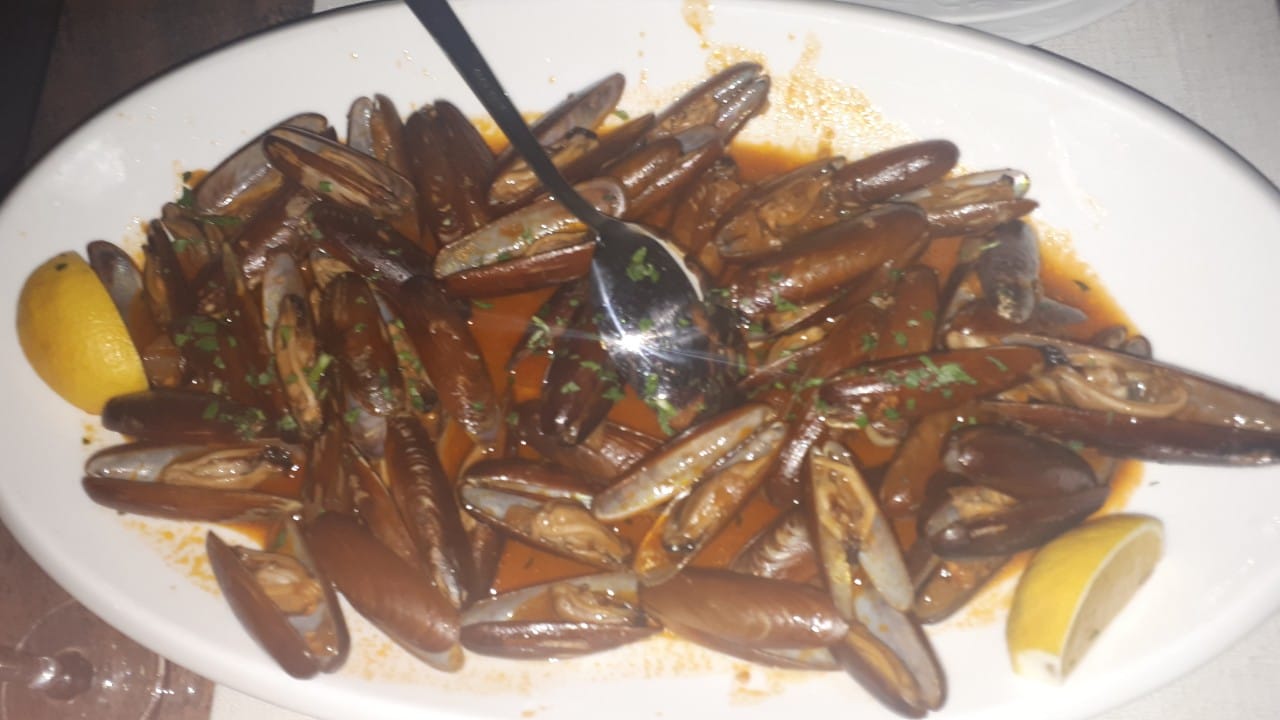
A lot of people also stop to shop. Food, drink and those beloved cigarettes are all cheaper than in Croatia, as is fuel, so a good idea to tank up.
If you have a little time, take a left on the main road at the traffic lights as you enter from Split. The historic town of Stolac is one of the most beautiful in the region and will give you a taste of the real Bosnia. It will leave you wanting more.
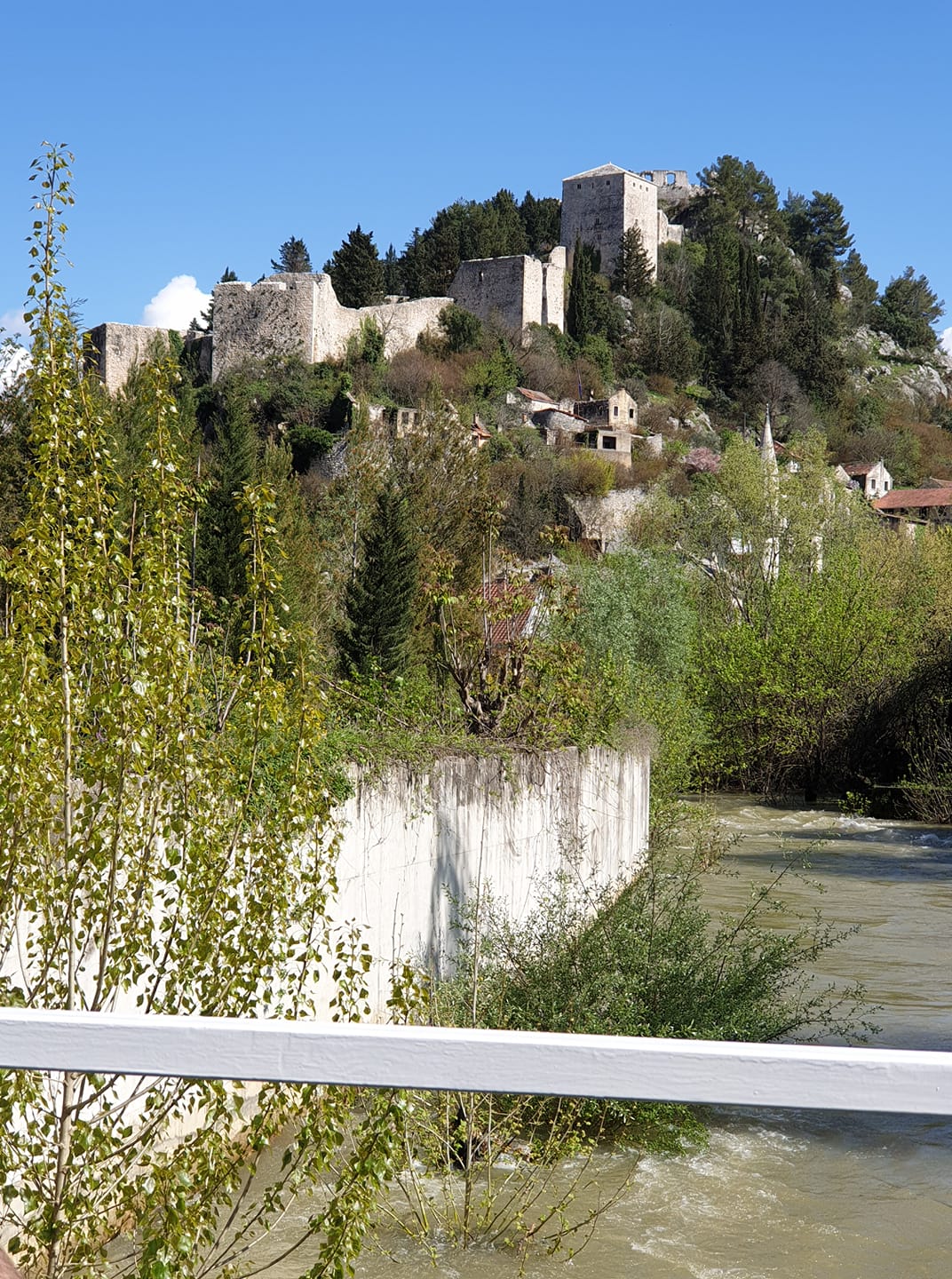
What currency is accepted when you transit the Neum corridor in Bosnia?
Pretty much anything! The town has thrived on its transit traffic for years, and every waiter seems to have various currency exchange rates programmed in his brain. I have used Bosnian Marks, Euro, kuna, US Dollars and British pounds over the years. The exchange rate of the mark is tied to the euro - one euro buys you about 1.95 KM (convertible marks, as they are known from their prior relationship with the Deutschemark).
Crossing the border from Croatia to Bosnia to Croatia - what about EU and Schengen?
Tourists are often very confused about Croatia's status regarding the EU, Schengen and border crossings. Croatia IS in the EU, but it is NOT YET in Schengen. It is scheduled to enter 'soon' (my favourite unit of time in this beautiful region - you can check the latest in this TCN section).
So if you are passing through Bosnia from Croatia to reenter the country, you have no Schengen issues. You will be leaving and reentering the EU, but in practice, you will be treated as a transit passenger.
Is it possible to go from Split to Dubrovnik without leaving Croatia?
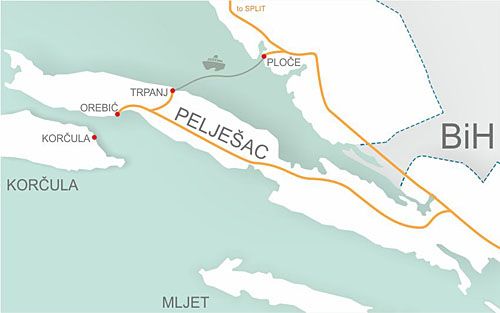
(Credit Dubrovnik Online Travel Guide)
Yes. And soon it will be even easier.
Currently, you can go from Split to Ploce. There is a short regular ferry to Trpanj on the Peljesac peninsula (home of the best Plavac Mali vineyards). At Trpnaj, turn right for the island of Korcula, or turn left and drive through the peninsula to the mainland on the other side of Neum, stopping as you must at Mali Ston, for some of the best oysters in the world.
But this trip is about to get a lot quicker.
The Peljesac Bridge - what is it and why will it change everything?
Some 30 years after it got independence, some people wonder why is Croatia split in two. it will not be for much longer. One of the key infrastructure projects for the last 30 years has been the construction of the so-called Peljesac Bridge, a 2.4 kilometre bridge which will connect the Croatian mainland on the Split side to the Peljesac peninsula, connecting both parts of Croatia for the first time.
The project has been dogged with problems over the years, and it has been something of a political football over the years. BiH objected because it would restrict access to Neum for certain types of shipping, it was claimed. In reality, the bridge will unite the two parts of Croatia and probably change the economy of Neum considerably, as there will be no need to cross the two borders.
Interestingly, several locals in Croatia have told me that they will continue to use the Neum route, as it will be quicker with less traffic, and those cigarettes ARE cheaper. I think I will too - I am quite fond of Orka restaurant, for nostalgic reasons.
When will the Peljesac Bridge be Finished?
How long is a piece of string? The project started back in (I think) 2007, but Chinese contractors were awarded the job a few years ago, and progress has been swift. The latest information is that the middle of 2022 will be the time when Croatia is finally united into one entity. You can follow the latest in this TCN section.
How is construction progress on the Peljesac Bridge?
Judge for yourself - the situation on February 15, 2021, with accompanying explanatory article.
Are there many other countries which are split in two?
Oh yes.
And quite a few, including some famous ones as Alaskans will tell you. Some strange ones such as the Kaliningrad enclave of Russia on the Polish Baltic. And Nackchivan, sandwiched between Iran and Armenia, is not ideally located for access from the rest of Azerbaijan. You can see more non-contiguous countries here.
Does Bosnia have the shortest coastline in the world?
Almost, apparently. Its 20 precious kilometres is beaten only by the 4.2 km of Monaco for shortness.
Does Croatia have any other strange border issues?
Oh, boy, does it ever. Enough for another complete article - one like this perhaps... Overview of Croatia’s Border Disputes with BiH, Montenegro, Serbia, Slovenia, Liberland. The article was written in 2017, and there may have been some slight developments, particularly with the arbitration in Piran with Slovenia.
Looking for more answers in our People Also Ask Google series? You can find them all here.
How to Drive from Split to Dubrovnik Without Leaving Croatia
July 24, 2018 - There can't be many countries in the world which are in two separate pieces, but Croatia is one. How to get from Split to Dubrovnik by car without driving through Bosnia and Hercegovina?
Need Help Getting from Split to Dubrovnik?
Dalmatia is in the heart of its peak summer season, and the crowds, which have not slowed down, are frantically jumping from town to town to make sure they see every piece of Dalmatia they possibly can. Let Solo Transfers help you this summer.
New Fast Boat Service from Split to Dubrovnik Begins Today!
There is another way to get from Split to Dubrovnik from today!
Your Journey from Split to Dubrovnik Made Easier by Solo Transfers
Need to book a transfer this summer? Look no further - Solo Transfers offers the best prices on private car transfers in Croatia.
Dubrovnik to Split to Dubrovnik: 2018 Guide How to Get There
How to get from Dubrovnik to Split? A comprehensive overview of Split to Dubrovnik options by car, bus, train, ferry, air and private transfer.
1. Can You Travel from Split to Dubrovnik by Train?
First, the bad news for train lovers. There is no train connection from Dubrovnik to Split. In fact, with the recent cessation of the Ploce to Sarajevo service, train services east of Split on the coast are almost non-existent. Dubrovnik DID have a fully functioning train station as recently as 40 years ago, but sadly no more. You can learn more about Dubrovnik and its train history here.

2. Getting from Dubrovnik to Split by Bus, and Vice Versa?
This is the most popular method of transport for budget transfers. Travel times are in the region of 4 and a half hours, but this can vary a little with the time of year and also potential delays at the Neum Corridor, a 22 km stretch of Bosnian coastal territory which separates Croatia from the rest of the country (more below). There are buses throughout the day, although less in the evening. Click here for an overview. Prices are approximately 150 kuna one way.
We also have great experience with Bus Croatia website, which includes online booking options. Apart from departure times, Bus Croatia also lists arrival times, prices and bus company. A true revolution in Croatian bus travel.

3. Organising a Dubrovnik Split Private Transfer
There are various private transfer options from Dubrovnik to Split of course, from chauffeur-driven car to speedboat, for example. Contact us with your needs at This email address is being protected from spambots. You need JavaScript enabled to view it..
PLEASE NOTE:
Private car transfers start at 200 euro one way. There is also a 20 euro discount from Split to Dubrovnik if you use the promo code "SOLONEWS" on the Solo Transfers website, where you can find out info about other transfers as well.
Private boat transfers from Dubrovnik to Split start at 1,700 euro one way.
If you are looking for a private transfer to the island of Hvar, this can be done by transfer to Drvenik, 86km before Split, ferry to Sucuraj, and onward to your destination.
The situation may be subject to change. If you have any other experiences or anything to add, email us at This email address is being protected from spambots. You need JavaScript enabled to view it. and we will update this travel advice.
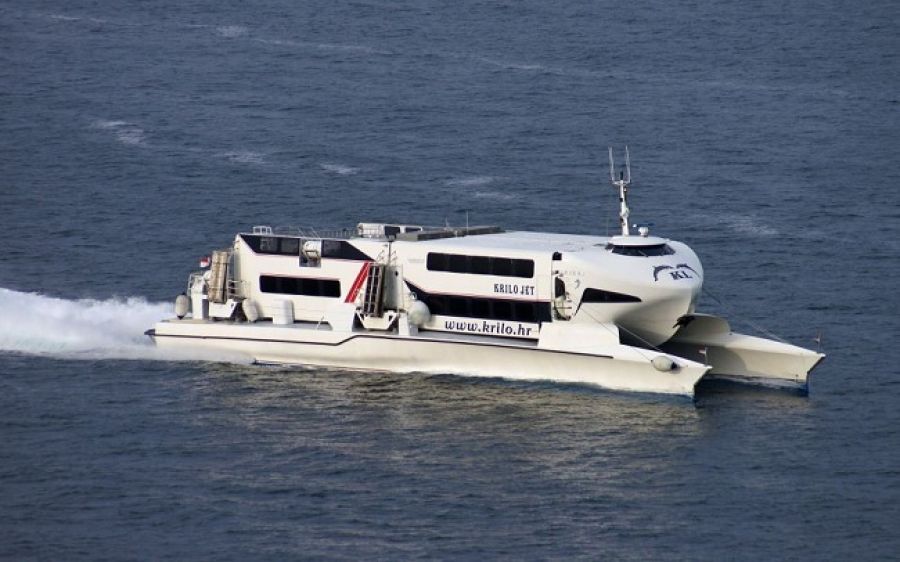
4. What are the Dubrovnik to Split Ferry and Catamaran Options?
One would have thought that ferry links between the two cities would be well established, but this is Croatia.
A couple of years ago, Krilo introduced a fabulous catamaran connection between Split and Dubrovnik for 170 kuna one way, stopping at Milna (Brac), Hvar Town, Korcula Town and Mljet (Pomena). The 2018 will continue, starting four times a week from May 2, going daily from June 1 to October 10, then three times a week until October 31, when it finishes for the season. Check the timetable for 2018 here.
In 2016, Krilo also had a direct catamaran service between the two cities, taking about three hours.
From 2017, the Krilo Eclipse operates a new route from Split-Brač (Bol)-Makarska-Korčula-Mljet (Sobra)-Dubrovnik. The Krilo Eclipse will leave from Split at 7:30 am and arrive in Dubrovnik at 12:00 pm. The return boat will leave Dubrovnik at 16:00 and arrive in Split at 20:30. You can find more information on the Krilo website.
State operator has also reported the reinstating of their popular car ferry route from Rijeka to Dubrovnik via Zadar, Split, Stari Grad on Hvar, Korcula and Mljet, but this has yet to be added to the summer schedule on their official website - check here for the latest.
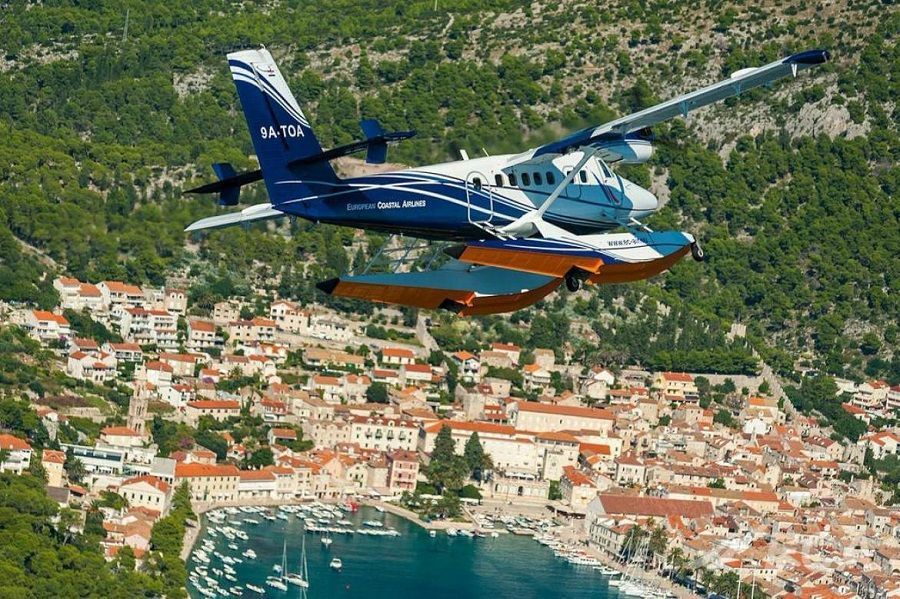
5. Can You Fly from Split to Dubrovnik by Plane/Seaplane?
Update for 2017: Unfortunately, the ECA seaplane service will not be running this year as the company has filed for pre-bankruptcy. There have been strong rumours of a replacement service, although we are unsure if it will be ready for the 2017 season. 2018 Update - although the rumours continued and announcements were made, no seaplane service appeared in 2018, and there is nothing concrete at time of writing for 2019.

6. Getting from Dubrovnik to Split by Car: Crossing the Neum Corridor and Border with Bosnia
The opening of the motorway to Ploce on the coast has opened up new options for tourists visiting Dalmatia, and for an overview of how smooth the ride is, click on this photo blog of a recent journey along it. The coastal road, although scenic, is slow, and traffic can build up in the season. If you can afford the 50 kuna toll, then head up to the motorway at Dugopolje, and enjoy the 114 km drive to Ploce. Once there, it is a short drive to the Neum Corridor, territory of Bosnia and Herzegovina, and outside the EU.
Do you need a visa? Do you need insurance? What has changed with EU entry? If you are looking for the definitive answer to the first two questions, I don't think it exists. In 99.9% of cases, no you do not need a visa or insurance. But...
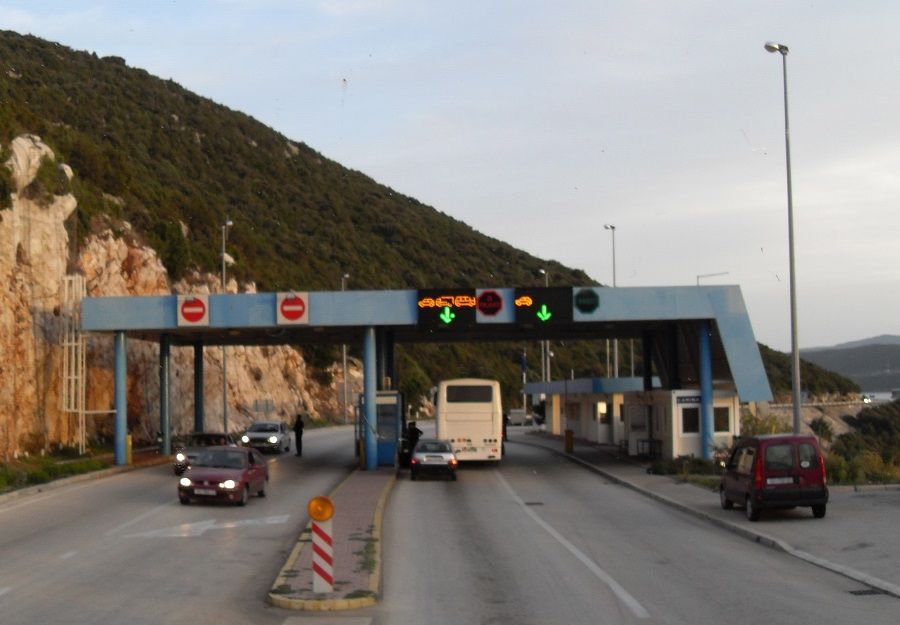
Here is what the Croatian Foreign Ministry reply was to the question a while ago:
"Referring to your e-mail message dated 16 August 2007, please be informed that according to the Agreement on a free transit through the territory of the Republic of Croatia to and from the Port of Ploce and through the territory of Bosnia and Herzegovina at Neum from the 22 November 1998 on the International border crossing Klek-Neum and Zaton Doli - Neum there is no border control for the foreigners who are transiting without stopping (by using the green track) through the Neum corridor"
Note: the legal position for driving across Bosnia’s Neum Corridor is murky. Bosnia and Croatia signed the Neum Agreement in 1998 which allows for Croatian registered vehicles to pass unhindered through this part of Bosnia. The agreement however was never ratified, by either side, i.e. this so-called Transit Corridor does not exist though it was, until 1 July, observed in practice (at least for Croatian cars).
In practice, I and many others have driven through with no problems whatsoever for years, nor any occasion to purchase insurance. Transit passengers without visas have also not had problems. Having said that, I have heard of two instances in 11 years here, where police in Neum stopped foreign cars and fined them for not having insurance for Bosnia.
It is Balkan rules. You may not need the insurance or the visa, but if a local policeman decides to interpret the rules a little differently... In 99.9% of cases there will be no problem.
My experience of the post-EU transit is that there are now more checks, and truck drivers are reporting more delays, but it has not had much effect on private cars. But in peak season, do allow extra time for border delays.
More current information from the Ministry website is encouraging:
What is the Neum Corridor?
It's a part of Bosnia-Herzegovina territory around Neum where separated parts of Croatia are connected. On both ends of the road 9.2 kms long are border crossings for international traffic, opened in April 2013.
Who can pass through the corridor?
This road can be used by all travelers, both Croatian (EU) and foreign citizens, according to EU custom rules. All the passengers with freedom of movement according to EU legislature (meaning citizens of EU, Switzerland, Liechtenstein, Iceland and Norway) who are travelling to Dubrovnik or from Dubrovnik can pass both borders with personal ID or passport, and carrying goods for personal use. Third countries citizens will pass border control by the EU legislature, meaning they will get a stamp in the passport each time they cross Croatian border. Same is for those who need visas for Croatia. Those with single-entry visa once when they cross the border and continue to Dubrovnik, won't be able to go back the same way, so they need a multiple-entry visa.
Considering visas for Bosnia, only Kosovo citizens need B-H visa, and refugees. Even they don't need visa if have Schengen visa.
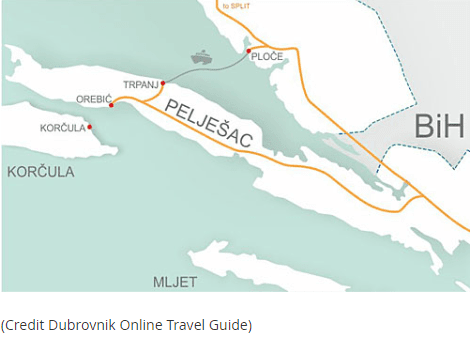
7. How to Drive from Dubrovnik to Split without Crossing the Border with Bosnia
If you are the type of person for whom 0.01% risk is too much, what are the options? Regarding visas and hire cars, check if the hire comes with a green card which will get you round the insurance issue. It is possible to avoid Bosnia altogether on a daily basis, but this will add time to your journey. At Ploce, head to the port for the short ferry to Trpanj on the Peljesac Peninsula, and then drive the length of Peljesac and on to Dubrovnik. Driving time from Split to Dubrovnik is about 3.5 - 4 hours (208 kilometres on the coastal roads).


